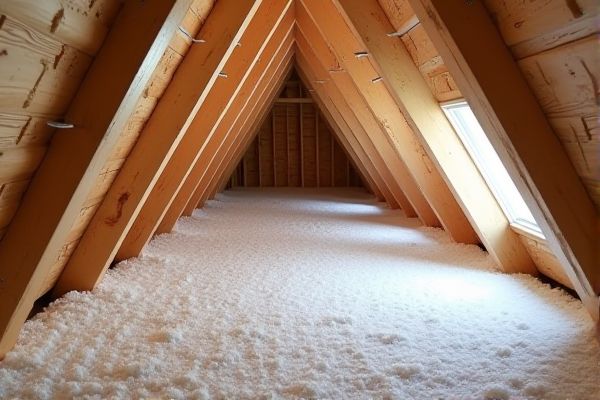
Closed-cell foam offers higher insulation value and better moisture resistance for your attic, making it ideal for energy efficiency and structural support. Discover how each foam type impacts your attic's performance and which option best fits your needs by reading the full article.
Table of Comparison
| Feature | Closed-Cell Foam | Open-Cell Foam |
|---|---|---|
| Density | High (2.0 lbs/ft3) | Low (0.5 lbs/ft3) |
| R-Value per Inch | 6.0 - 7.0 | 3.5 - 4.0 |
| Moisture Resistance | Water-resistant, acts as a vapor barrier | Permeable to moisture |
| Air Sealing | Excellent air barrier | Good air barrier, but less effective |
| Cost | Higher ($1.50 - $3.00 per sq ft) | Lower ($0.44 - $0.65 per sq ft) |
| Application | Best for tight spaces, below-grade walls, attics | Best for interior walls, attics with ventilation |
| Structural Strength | Adds rigidity to structure | Does not add structural strength |
| Soundproofing | Moderate sound dampening | Better sound absorption |
| Environmental Impact | Higher Global Warming Potential (GWP) | Lower GWP, more eco-friendly options |
Overview of Closed-Cell and Open-Cell Foam
Closed-cell foam is a dense insulation material with cells that are tightly packed, providing superior thermal resistance and moisture barrier properties ideal for attics prone to humidity. Open-cell foam consists of softer, more porous cells that allow air to pass through, offering sound absorption and flexibility but lower R-value compared to closed-cell foam. Choice between these foams depends on attic conditions, desired insulation performance, and budget constraints.
Key Differences Between Closed-Cell and Open-Cell Foam
Closed-cell foam features a dense, rigid structure with high R-value per inch, providing superior insulation and moisture resistance for attic applications. Open-cell foam has a softer, more porous texture, allowing it to expand easily and offer excellent air sealing but lower R-value and less moisture protection. Your choice depends on energy efficiency goals, budget, and whether moisture control or soundproofing is a priority in the attic space.
Insulation Performance: R-Value Comparison
Closed-cell foam offers a higher R-value per inch, typically around 6 to 7, providing superior thermal resistance and moisture barrier compared to open-cell foam, which usually has an R-value of about 3.5 to 4 per inch. Your attic insulation benefits from closed-cell foam's dense structure, which better resists heat flow and reduces air infiltration. Choosing the right foam can significantly enhance energy efficiency and maintain consistent indoor temperatures.
Moisture Resistance and Vapor Barrier Qualities
Closed-cell foam offers superior moisture resistance due to its dense structure that prevents water absorption and acts as an effective vapor barrier, making it ideal for attic insulation. Open-cell foam, with its porous nature, allows moisture to pass through and does not provide a strong vapor barrier, potentially leading to condensation and mold issues in attic spaces. Your choice between the two should consider the local climate and moisture control needs to ensure optimal attic performance and durability.
Air Sealing Capabilities in Attic Applications
Closed-cell foam provides superior air sealing in attic applications due to its dense structure, effectively blocking air infiltration and exfiltration. Open-cell foam, being more porous, allows some air movement, reducing its effectiveness as an air barrier. The higher R-value per inch of closed-cell foam further enhances thermal performance by minimizing air leakage and increasing energy efficiency.
Structural Strength and Durability
Closed-cell foam provides superior structural strength and durability in attic applications due to its high density and rigid cellular structure, which enhances building stability and resists moisture infiltration. Open-cell foam, being less dense and flexible, offers limited structural support and is more susceptible to shrinkage and damage over time. Choosing closed-cell foam ensures long-term durability and improved resistance to environmental stressors in attic insulation.
Installation Process and Practical Considerations
Closed-cell foam requires professional installation due to its high density and the need for specialized equipment to ensure proper application and curing, making it more costly but highly effective for moisture and air barrier purposes. Open-cell foam is easier to install with standard spray equipment and expands on application, allowing for better filling of irregular spaces and faster drying times, which suits DIY projects and budget-conscious homeowners. In attics, closed-cell foam offers higher R-value per inch and structural reinforcement, while open-cell foam provides sound dampening and breathability, impacting ventilation and potential moisture accumulation.
Cost Analysis: Closed-Cell vs Open-Cell Foam
Closed-cell foam typically costs more per board foot than open-cell foam due to its higher density and superior insulating properties. Despite the higher initial investment, closed-cell foam offers greater energy savings and moisture resistance, which can reduce long-term expenses in your attic insulation. Open-cell foam is more affordable upfront but may require additional air sealing or moisture barriers to achieve similar performance.
Energy Efficiency and Long-Term Savings
Closed-cell foam offers superior energy efficiency in attics due to its higher R-value per inch and moisture resistance, creating a more effective air barrier and reducing heat transfer. Open-cell foam, while less expensive, has a lower R-value and is more susceptible to moisture, potentially leading to increased energy costs over time. Choosing closed-cell foam for your attic insulation maximizes long-term savings by improving thermal performance and durability.
Choosing the Right Foam for Your Attic
Closed-cell foam offers higher R-value per inch and superior moisture resistance, making it ideal for attics prone to humidity or water infiltration. Open-cell foam is more cost-effective and provides excellent air sealing but has a lower R-value and absorbs moisture. Choosing the right foam for your attic depends on your climate, budget, and specific insulation needs to maximize energy efficiency and durability.
 homyna.com
homyna.com